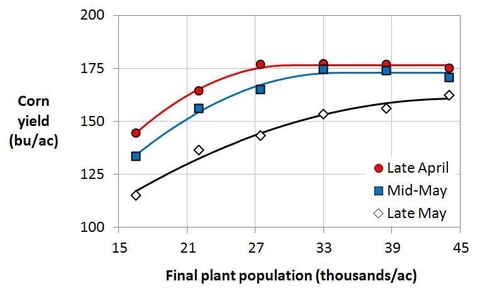When wet soil conditions delay corn planting, questions about agronomic decisions are raised.
Yield penalty for late-planted corn
Long-term data indicate that corn in Minnesota generally needs to be planted by mid-May to avoid yield losses greater than 9 percent (Table 1). Average yields were reduced by 8 percent when planting was delayed until May 20, and by 18 percent when planting was delayed until May 30.
On average, each one-day delay in planting reduces yield by 0.5 percent from April 30 to May 20. From May 20 to 30, yield reductions increase on average to 1 percent per day. After May 30, yield reductions due to delayed planting average about 1.2 percent per day.
Table 1: How planting date affects corn yield, as a percent of maximum
| Planting date | Percent of maximum grain yield; Study 1: Lamberton; (1988-2003) | Percent of maximum grain yield; Study 2: Lamberton, Morris and Waseca; (2009-2011) |
|---|---|---|
| April 20 | 99% | 98% |
| April 25 | 100% | 99% |
| April 30 | 100% | 100% |
| May 5 | 99% | 100% |
| May 10 | 98% | 99% |
| May 15 | 95% | 98% |
| May 20 | 92% | 95% |
| May 25 | 87% | 92% |
| May 30 | 82% | 89% |
| June 4 | 76% | 84% |
| June 9 | 69% | 79% |
Latest recommended planting dates
-
June 5: In central and northern Minnesota, if harvesting corn for grain.
-
June 10: In southern Minnesota, if harvesting corn for grain.
-
June 12: In central and northern Minnesota, if harvesting for corn silage.
-
June 20: In southern Minnesota, if harvesting corn for silage.
Corn maturities to use
Growers should stick with their planned seed corn choices until the last week in May.
When planting is delayed until May 22 or later, it will be a good risk management strategy to reduce the relative maturity of the corn hybrids that will be planted.
Use the information in Table 2 to guide your decisions regarding corn maturity for late planting.
Table 2: Corn maturity guidelines for late planting in Minnesota
| Planting date | Relative maturity (RM) units earlier than full-season for the region |
|---|---|
| Prior to May 22 | Plant normal seed choices |
| May 22 to 28 | 5 to 7 relative maturity units |
| May 29 to June 4 | 8 to 15 relative maturity units |
| June 5 to 10 | 15 or more relative maturity units |
Seeding rate changes
If soil conditions with late planting are better for emergence than those with earlier planting dates, slightly fewer seeds may be needed to get a given final plant population.
Research conducted in Lamberton and Waseca found that the optimum plant populations were not affected if corn was planted by mid-May (Figure 1). However, when planting was delayed until late May, a higher plant population was needed to maximize yield.
Planting depth changes
If planting late in very dry conditions, growers may consider planting deeper (as deep as 2.5 inches) to ensure the presence of adequate soil moisture in the seed zone for germination. However, it’s more common for delayed planting to result from wet field conditions.
In general, a planting depth of 1.75 to 2 inches is optimal for most planting dates.
While a 1.5-inch planting depth often works, it increases the risk of poorly established nodal roots between the seed and the soil surface.
Poor nodal root establishment is commonly associated with both shallow planting and a very dry and fluffy soil surface.
It is also associated with shallow planting followed by heavy rains. Rains settle the soil surface, resulting in seed placement that is shallower than originally desired.
Nafziger, E.D. (2002). Corn. In Illinois Agronomy Handbook (chapter 2). Retrieved from Corn.
Reviewed in 2022


